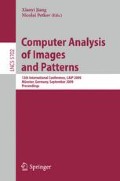Abstract
Saliency mechanism has been considered crucial in the human visual system and helpful to object detection and recognition. This paper addresses an information theoretic model for visual saliency detection. It consists of two steps: first, using the Non-negative Matrix Factorization with sparseness constraints (NMFsc) algorithm to learn the basis functions from a set of randomly sampled natural image patches; and then, applying information theoretic principle to generate the saliency map by the Salient Information (SI) which is calculated from the coefficients represented by basis functions. We compare our model with the previous methods on natural images. Experimental results show that our model performs better than existing approaches.
Access this chapter
Tax calculation will be finalised at checkout
Purchases are for personal use only
Preview
Unable to display preview. Download preview PDF.
References
Fergus, R., Perona, P., Zisserman, A.: Object Class Recognition by Unsupervised Scale-invariant Learning. In: IEEE Computer Society Conference on Computer Vision and Pattern Recognition (2003)
Treisman, A., Gelade, G.: A Feature-Integration Theory of Attention. Cognitive Psychology 12(1), 97–136 (1980)
Itti, L., Koch, C., Niebur, E.: A Model of Saliency-Based Visual Attention for Rapid Scene Analysis. TPAMI 20(11), 1254–1259 (1998)
Oliva, A., Torralba, A., Castelhano, M., Henderson, J.: Top-down control of visual attention in object detection. In: IEEE International Conference on Image Processing (2003)
Harel, J., Koch, C., Perona, P.: Graph-Based Visual Saliency. In: Advances in Neural Information Processing Systems (2007)
Bruce, N., Tsotsos, J.: Saliency Based on Information Maximization. In: Advances in Neural Information Processing Systems, vol. 18 (2006)
Hou, X., Zhang, L.: Saliency Detection: A Spectral Residual Approach. In: IEEE Computer Society Conference on Computer Vision and Pattern Recognition (2007)
Hoyer, P.: Non-negative matrix factorization with sparseness constraints. Journal of Machine Learning Research 14, 1457–1469 (2004)
Olshausen, B., Field, D.: Natural image statistics and efficient coding. Network: Computation in Neural Systems 14, 333–339 (1996)
Hoyer, P.: Non-negative sparse coding. In: Proc. IEEE Workshop on Neural Networks for Signal Processing, vol. 12, pp. 557–565 (2002)
Engel, S., Zhang, X., Wandell, B.: Colour Tuning in Human Visual Cortex Measured With Functional Magnetic Resonance Imaging. Nature 388(6637), 68–71 (1997)
Hou, X., Zhang, L.: Dynamic Visual Attention: Searching for coding length increments. In: Advances in Neural Information Processing Systems (2008)
Shannon, C.: A mathematical theory of communication. Bell System Technical Journal 27, 93–154 (1948)
Frey, H.P., König, P., Einhäuser, W.: The Role of First-and Second-Order Stimulus Features for Human Overt Attention. Perception and Psychophysics 69, 153–161 (2007)
Walther, D., Koch, C.: Modeling attention to salient proto-objects. Neural Networks 19, 1395–1407 (2006)
Tatler, B., Baddeley, R., Gilchrist, I.: Visual correlates of fixation selection: effects of scale and time. Vision Research 14, 643–659 (2005)
van der Linde, I., Rajashekar, U., Bovik, A., Cormack, L.: DOVES: A Database of Visual Eye Movements. Spatial Vision (2008) (in press)
Author information
Authors and Affiliations
Editor information
Editors and Affiliations
Rights and permissions
Copyright information
© 2009 Springer-Verlag Berlin Heidelberg
About this paper
Cite this paper
Liu, J., Liu, Y. (2009). A Model for Saliency Detection Using NMFsc Algorithm. In: Jiang, X., Petkov, N. (eds) Computer Analysis of Images and Patterns. CAIP 2009. Lecture Notes in Computer Science, vol 5702. Springer, Berlin, Heidelberg. https://doi.org/10.1007/978-3-642-03767-2_37
Download citation
DOI: https://doi.org/10.1007/978-3-642-03767-2_37
Publisher Name: Springer, Berlin, Heidelberg
Print ISBN: 978-3-642-03766-5
Online ISBN: 978-3-642-03767-2
eBook Packages: Computer ScienceComputer Science (R0)

